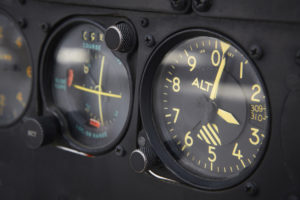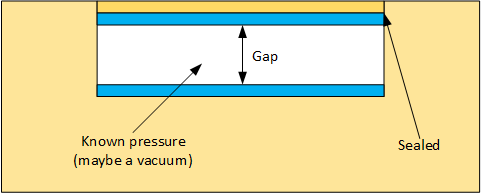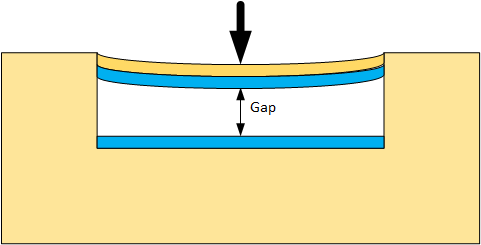
[From the last episode: Sensor fusionThe process of combining information from multiple sensors (real or virtual) in order either to give more confidence in a result or to come up with something completely new. can help gyros and magnetometersA sensor that detects magnetic fields -- from the earth or from anywhere else. correct each other, and it can turn a magnetometer into a compassIn its electronic version, a magnetometer that has its reading compensated by a tilt meter (done by an accelerometer)..]
We’ve covered basic navigation in the last couple posts, but our focus has been only on finding out where we are on the surface of the earth. Nothing tells us what our altitude is – there’s no third dimension. It doesn’t matter on a road, because the road constrains your elevation – hopefully, you’re always firmly in contact with the road surface.
But some navigation systems want to help you maneuver through a mall – which may have multiple levels. Or a system might be telling you where you are with respect to an open parking spot that’s waiting for you in a parking garage three floors above you. How can the system tell which floor you’re currently on so that it can give you proper directions?
How High Are You?
Technically, GPSGlobal Positioning System. A satellite system that sends signals to earth. GPS receivers can get those and figure out where on the earth you are. This is specifically a US-based system, an example of the more generic term “GNSS.” can help, but it’s not very good at the third dimension. But there’s another kind of sensor that can give us vertical positioning, and it’s been used for decades in airplanes: a pressure sensor. Air pressure increases as you go up, so a pressure sensor can tell you your height – if the system translates the pressure into feet (or meters) above sea level.
There’s a catch here, but, before we get into that, let’s look at how we could make a micro-scale pressure sensor.
There are lots of ways to measure pressure – both using macro-scale techniques and using MEMS. Some approaches give more accuracy or better performance at high temperatures or the ability to detect very high or very low pressures.
Another distinction is, are you simply trying to measure the absolute value of something like air or a liquid? Or are you trying to figure out the pressure one place compared to the pressure someplace else? In fact, all pressure measurements are “as compared to what?”; it’s just that some compare to a fixed value (as we’ll see below), while others compare to something else that you connect to it. These are all considerations driving how to make the sensor.
Feeling the Pressure
We’ll look at a common approach with a couple variants. Let’s say you make a thin membrane – a diaphragm – that seals a cavity below that has some known pressure. What pressure would it have? Well, whatever pressure was in the environment when you sealed it off. If you “attached” the diaphragm in a vacuum, then that vacuum would be trapped beneath the seal. But here’s the important point: whoever builds the sensor knows what that pressure is. That way they can compare any other pressure to that one.

When you get some outside pressure, it pushes in the diaphragm, and we can measure this a couple of ways.

In the drawing above, we have two blue materials. Those are metal. You may remember from before that we can measure gaps using capacitanceCapacitance is the ability of an electron or hole to “feel” other electrons or holes on the other side of a small gap. The gap prevents actual current from flowing, but, if small enough, electrons and holes can pile up on either side of the gap. Specific devices that make use of this are called capacitors., and the gap between the two metal plates gets smaller when one of them bends. You can measure that change in the gap, which then tells you, assuming you know all the stiffness properties of the diaphragm and the pressure in the cavity, what the outside pressure is. Yeah, it takes some math – but circuits are good at that.
Another way to measure the bend in the diaphragm is to use a piezoelectric material. We saw before that such a material changes electrically when it bends, so we can use that change (again, knowing all the material properties and crunching the math) to figure out the pressure.
But There’s a Catch
So this is great for measuring air pressure, which can tell us our altitude. Ideally, once we know the air pressure, we know how high up we are (as compared to sea level). Except for one thing: the air pressure changes not only because we change altitude, but also because of the weather. Storm coming? The air pressure drops. Clear and sunny? The pressure is high.
So we need to adjust our readings for the weather. If we don’t, and a storm comes in, then our nav system will think that we moved to a higher altitude – without actually moving – because the pressure dropped.
So how do we correct for this? Of course, by using another virtual sensorA source of data that, strictly speaking, isn’t a sensor, but that can be used as if it were a sensor.: the weather report. If the gadget – like your phone – has an internet connectionThis refers to some kind of electrical connection. It might be through a network cable, a cable connection, a wireless connection, or a phone - just to name some options. The connection might be to the internet or to some other local device., it can (at least in principle) consult with a weather databaseA structured way of storing data and relating different pieces of data to each other. (Like, which address belongs to which person.) There are “query” languages, the best-known of which is SQL, that let you enter data into the database, change data that’s already in the database, and retrieve data from the database. for your location. Sound fussy? Maybe, but pilots have long had to adjust their old-school altimeters to account for the weather on any given flight. So that’s no different, except that, in our case, the interwebs are doing it instead of a human.
So this ends our discussion of navigation, and it almost ends our discussion of sensorsA device that can measure something about its environment. Examples are movement, light, color, moisture, pressure, and many more.. But we’ll cover one more important type of sensor next week before moving on.

Leave a Reply